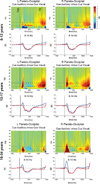Neuro-oscillatory mechanisms of intersensory selective attention and task switching in school-aged children, adolescents and young adults
- PMID: 26190204
- PMCID: PMC5361894
- DOI: 10.1111/desc.12316
Neuro-oscillatory mechanisms of intersensory selective attention and task switching in school-aged children, adolescents and young adults
Abstract
The ability to attend to one among multiple sources of information is central to everyday functioning. Just as central is the ability to switch attention among competing inputs as the task at hand changes. Such processes develop surprisingly slowly, such that even into adolescence, we remain slower and more error prone at switching among tasks compared to young adults. The amplitude of oscillations in the alpha band (~8-14 Hz) tracks the top-down deployment of attention, and there is growing evidence that alpha can act as a suppressive mechanism to bias attention away from distracting sensory input. Moreover, the amplitude of alpha has also been shown to be sensitive to the demands of switching tasks. To understand the neural basis of protracted development of these executive functions, we recorded high-density electrophysiology from school-aged children (8-12 years), adolescents (13-17), and young adults (18-34) as they performed a cued inter-sensory selective attention task. The youngest participants showed increased susceptibility to distracting inputs that was especially evident when switching tasks. Concordantly, they showed weaker and delayed onset of alpha modulation compared to the older groups. Thus the flexible and efficient deployment of alpha to bias competition among attentional sets remains underdeveloped in school-aged children.
© 2015 John Wiley & Sons Ltd.
Figures






Similar articles
-
Susceptibility to distraction in autism spectrum disorder: probing the integrity of oscillatory alpha-band suppression mechanisms.Autism Res. 2014 Aug;7(4):442-58. doi: 10.1002/aur.1374. Epub 2014 Mar 27. Autism Res. 2014. PMID: 24678054 Free PMC article.
-
Functional brain networks for sensory maintenance in top-down selective attention to audiovisual inputs.IEEE Trans Neural Syst Rehabil Eng. 2013 Sep;21(5):734-43. doi: 10.1109/TNSRE.2013.2272219. Epub 2013 Jul 4. IEEE Trans Neural Syst Rehabil Eng. 2013. PMID: 23846491
-
Top-down control of the phase of alpha-band oscillations as a mechanism for temporal prediction.Proc Natl Acad Sci U S A. 2015 Jul 7;112(27):8439-44. doi: 10.1073/pnas.1503686112. Epub 2015 Jun 22. Proc Natl Acad Sci U S A. 2015. PMID: 26100913 Free PMC article.
-
Selective attention and attention switching: towards a unified developmental approach.Dev Sci. 2010 Jul;13(4):622-35. doi: 10.1111/j.1467-7687.2009.00921.x. Dev Sci. 2010. PMID: 20590726 Free PMC article. Review.
-
Perceptual Cycles.Trends Cogn Sci. 2016 Oct;20(10):723-735. doi: 10.1016/j.tics.2016.07.006. Epub 2016 Aug 23. Trends Cogn Sci. 2016. PMID: 27567317 Review.
Cited by
-
An fNIRS Study of Applicability of the Unity-Diversity Model of Executive Functions in Preschoolers.Brain Sci. 2022 Dec 16;12(12):1722. doi: 10.3390/brainsci12121722. Brain Sci. 2022. PMID: 36552181 Free PMC article.
-
Anticipation across modalities in children and adults: Relating anticipatory alpha rhythm lateralization, reaction time, and executive function.Dev Sci. 2023 Jan;26(1):e13277. doi: 10.1111/desc.13277. Epub 2022 Jun 7. Dev Sci. 2023. PMID: 35616474 Free PMC article.
-
Neural measures of anticipatory bodily attention in children: Relations with executive function.Dev Cogn Neurosci. 2018 Nov;34:148-158. doi: 10.1016/j.dcn.2018.08.002. Epub 2018 Sep 29. Dev Cogn Neurosci. 2018. PMID: 30448644 Free PMC article.
-
Informing the Structure of Executive Function in Children: A Meta-Analysis of Functional Neuroimaging Data.Front Hum Neurosci. 2017 Apr 7;11:154. doi: 10.3389/fnhum.2017.00154. eCollection 2017. Front Hum Neurosci. 2017. PMID: 28439231 Free PMC article.
-
The Higher, More Complicated: The Neural Mechanism of Hierarchical Task Switching on Prefrontal Cortex.Brain Sci. 2022 May 14;12(5):645. doi: 10.3390/brainsci12050645. Brain Sci. 2022. PMID: 35625031 Free PMC article. Review.
References
-
- Allport A, Wylie G. Task switching, stimulus-response bindings, and negative priming. Control of cognitive processes: Attention and performance XVIII. 2000:35–70.
-
- Ashtari M, Cervellione KL, Hasan KM, Wu J, McIlree C, Kester H, Ardekani BA, Roofeh D, Szeszko PR, Kumra S. White matter development during late adolescence in healthy males: a cross-sectional diffusion tensor imaging study. NeuroImage. 2007;35:501–510. - PubMed
-
- Banerjee S, Snyder AC, Molholm S, Foxe JJ. Oscillatory alpha-band mechanisms and the deployment of spatial attention to anticipated auditory and visual target locations: supramodal or sensory-specific control mechanisms? The Journal of neuroscience : the official journal of the Society for Neuroscience. 2011;31:9923–9932. - PMC - PubMed
-
- Bell AJ, Sejnowski TJ. An information-maximization approach to blind separation and blind deconvolution. Neural computation. 1995;7:1129–1159. - PubMed
Publication types
MeSH terms
Grants and funding
LinkOut - more resources
Full Text Sources
Other Literature Sources

